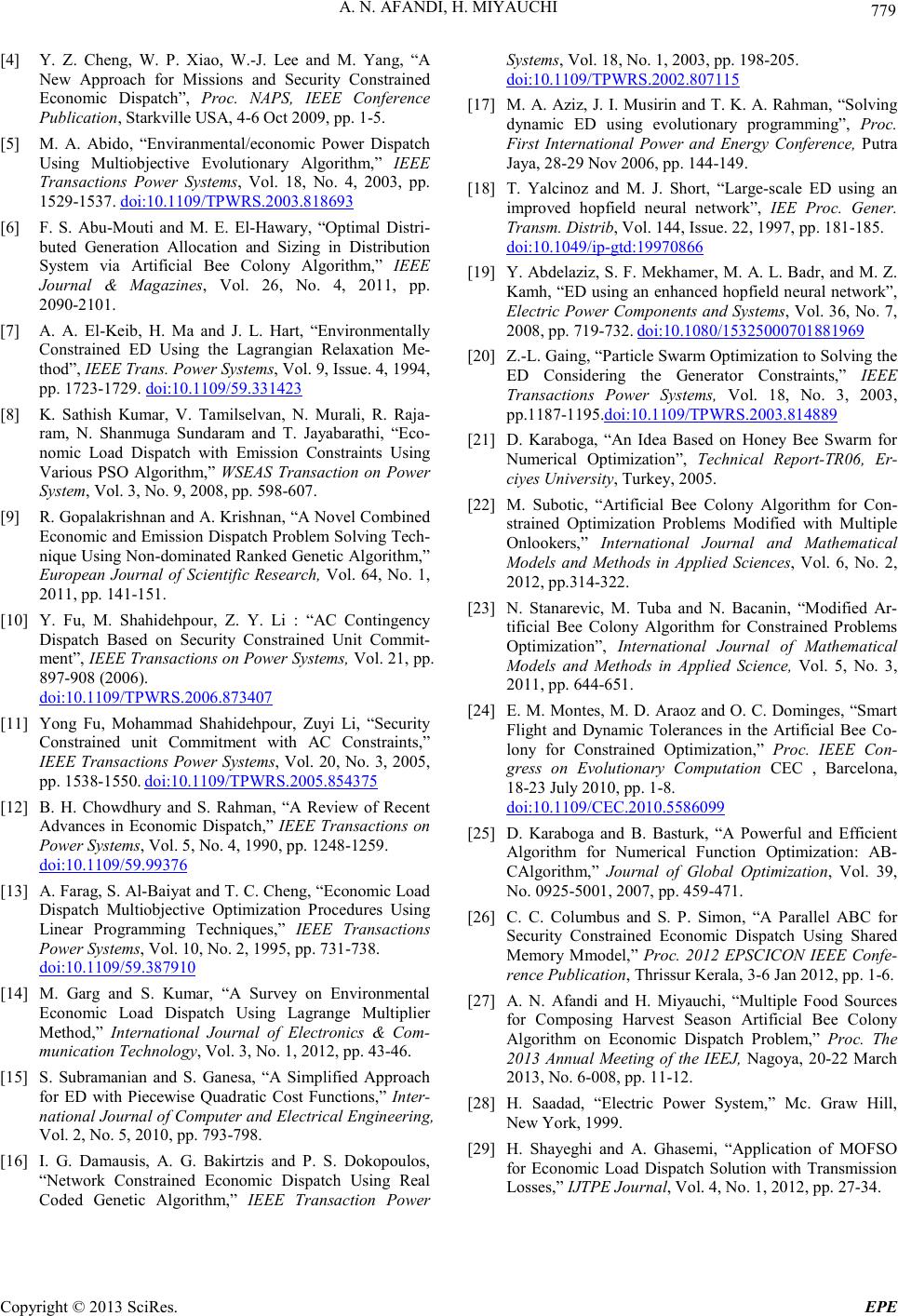
A. N. AFANDI, H. MIYAUCHI
Copyright © 2013 SciRes. EPE
[4] Y. Z. Cheng, W. P. Xiao, W.-J. Lee and M. Yang, “A
New Approach for Missions and Security Constrained
Economic Dispatch”, Proc. NAPS, IEEE Conference
Publication, Starkville USA, 4-6 Oct 2009, pp. 1-5.
[5] M. A. Abido, “Enviranmental/economic Power Dispatch
Using Multiobjective Evolutionary Algorithm,” IEEE
Transactions Power Systems, Vol. 18, No. 4, 2003, pp.
1529-1537. doi:10.1109/TPWRS.2003.818693
[6] F. S. Abu-Mouti and M. E. El-Hawary, “Optimal Distri-
buted Generation Allocation and Sizing in Distribution
System via Artificial Bee Colony Algorithm,” IEEE
Journal & Magazines, Vol. 26, No. 4, 2011, pp.
2090-2101.
[7] A. A. El-Keib, H. Ma and J. L. Hart, “Environmentally
Constrained ED Using the Lagrangian Relaxation Me-
thod”, IEEE Trans. Power Systems, Vol. 9, Issue . 4, 1994,
pp. 1723-1729. doi:10.1109/59.331423
[8] K. Sathish Kumar, V. Tamilselvan, N. Murali, R. Raja-
ram, N. Shanmuga Sundaram and T. Jayabarathi, “E co-
nomic Load Dispatch with Emission Constraints Using
Various PSO Algorithm,” WSEAS Transaction on Power
System, Vol. 3, No. 9, 2008, pp. 598-607.
[9] R. Gopalakrishnan and A. Krishnan, “A Novel Combined
Economic and Emission Dispatch Problem Solving Tech-
nique Using Non-dominated Ranked Genetic Algorithm,”
European Journal of Scientific Research, Vol. 64, No. 1,
2011, pp. 141-151.
[10] Y. Fu, M. Shahidehpour, Z. Y. Li : “AC Contingency
Dispatch Based on Security Constrained Unit Commit-
ment”, IEEE Transactions on Power Systems, Vol. 21, pp.
897-908 (2006).
doi:10.1109/TPWRS.2006.873407
[11] Yong Fu, Mohammad Shahidehpour, Zuyi Li, “Security
Constrained unit Commitment with AC Constraints,”
IEEE Transactions Power Systems, Vol. 20, No. 3, 2005,
pp. 1538-1550. doi:10.1109/TPWRS.2005.854375
[12] B. H. Chowdhury and S. Rahman, “A Review of Recent
Advances in Economic Dispatch,” IEEE Transactions on
Power Systems, Vol. 5, No. 4, 1990, pp . 1248-1259.
doi:10.1109/59.99376
[13] A. Farag, S . Al-Baiyat and T. C. Cheng, “Economic Load
Dispatch Multiobjective Optimization Procedures Using
Linear Programming Techniques,” IEEE Transactions
Power Systems, Vol. 10, No. 2, 199 5, pp. 731-738.
doi:10.1109/59.387910
[14] M. Gar g and S. Kumar, “A Survey on Environmental
Economic Load Dispatch Using Lagrange Multiplier
Method,” International Journal of Electronics & Com-
munication Technology, Vol. 3, No . 1, 2012, pp. 43-46.
[15] S. Subramanian and S. Ganesa, “A Simplified Approach
for ED with Piecewise Quadratic Cost Functions,” Inter-
national Journal of Computer and Electrical Engineering,
Vol. 2, No. 5, 2010, pp. 793-798.
[16] I. G. Damausis, A. G. Bakirtzis and P. S. Dokopoulos,
“Network Constrained Economic Dispatch Using Real
Coded Genetic Algorithm,” IEEE Transaction Power
Systems, Vol. 18, No. 1, 2003, pp. 198-205.
doi:10.1109/TPWRS.2002.807115
[17] M. A. Aziz, J. I. Musirin and T. K. A. Rahman, “Solving
dynamic ED using evolutionary programming”, Proc.
First International Power and Energy Conference, Putra
Jaya, 28-29 Nov 2006, pp. 144-149.
[18] T. Yalcinoz and M. J. Short, “Large-scale ED using an
improved hopfield neural network”, IEE Proc. Gener.
Transm. Di strib, Vol . 14 4, Iss ue . 22, 19 97, pp. 181-185.
doi:10.1049/ip-gtd:19970866
[19] Y. Abdelaziz, S. F. Mekhamer, M. A. L. Badr, and M. Z.
Kamh, “ED using an enhanced hopfield neural network”,
Electric Power Components and Systems, Vol. 36, N o. 7,
2008, pp. 719-732. doi:10.1080/15325000701881969
[20] Z.-L. Gaing, “P art icle Swarm Optimization to Solving the
ED Considering the Generator Constraints,” IEEE
Transactions Power Systems, Vol. 18, No. 3, 2003,
pp.1187-1195.doi:10.1109/TPWRS.2003.814889
[21] D. Karaboga, “An Idea Based on Honey Bee Swarm for
Numerical Optimization”, Technical Report-TR06, Er-
ciyes Universi ty, Turkey, 2005.
[22] M. Subotic, “Artificial Bee Colony Algorithm for Con-
strained Optimization Problems Modified with Multiple
Onlookers,” International Journal and Mathematical
Models and Methods in Applied Sciences, Vol. 6, No. 2,
2012, pp .314-322.
[23] N. Stanarevic, M. Tuba and N. Bacanin, “Modified Ar-
tificial Bee Colony Algorithm for Constrained Problems
Optimization”, International Journal of Mathematical
Models and Methods in Applied Science, Vol. 5, No. 3,
2011, pp . 644-651.
[24] E. M. Montes, M. D. Araoz and O. C. Dominges, “Smart
Flight and Dynamic Tolerances in the Artificial Bee Co-
lony for Constrained Optimizatio n,” Proc. IEEE Con-
gress on Evolutionary Computation CEC , Barcelona,
18-23 July 2010, pp. 1-8.
doi:10.1109/CEC.2010.5586099
[25] D. K ar aboga and B. Basturk, “A Powerful and Efficient
Algorithm for Numerical Function Optimization: AB-
CAlgorithm,” Journal of Global Optimization, Vol. 39,
No. 0925-5001, 2007, pp. 459-471.
[26] C. C. Columbus and S. P. Simon, “A Parallel ABC for
Security Constrained Economic Dispatch Using Shared
Memory Mmodel,” Proc. 2012 EPSCICON IEEE Confe-
rence Pu blication, Thrissu r K er ala, 3-6 Jan 2012, pp. 1-6.
[27] A. N. Afandi and H. Miyauchi, “Multiple Food Sources
for Composing Harvest Season Artificial Bee Colony
Algorithm on Economic Dispatch Problem,” Proc. The
2013 Annual Meeting of the IEEJ, Nagoya, 20-22 March
2013, No. 6-008, pp. 11-12.
[28] H. Saadad, “Electric Power System,” Mc. Graw Hill,
New York, 1999.
[29] H. Shayeghi and A. Ghasemi, “Application of MOFSO
for Economic Load Dispatch Solution with Transmission
Losses,” IJTPE Journal, Vol. 4, No. 1, 2012, pp. 27-34.